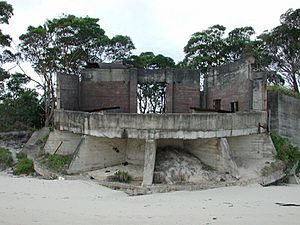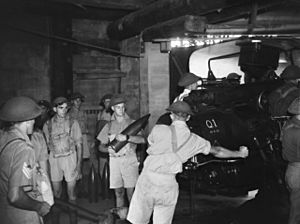Fort Cowan Cowan facts for kids
Quick facts for kids Fort Cowan Cowan |
|
|---|---|

Gun emplacement, Fort Cowan Cowan
|
|
| Location | 30 Jessie Wadsworth Street, Moreton Island, City of Brisbane, Queensland, Australia |
| Official name: Fort Cowan Cowan (Cowan Cowan Battery), RAN 3 Cowan Cowan, Fort Cowan | |
| Type | state heritage (archaeological, built) |
| Designated | 1 October 2007 |
| Reference no. | 602559 |
| Significant period | 1939-45 |
| Significant components | magazine / explosives store, gun emplacement |
| Lua error in Module:Location_map at line 420: attempt to index field 'wikibase' (a nil value). | |
Fort Cowan Cowan is a historic World War II fort located on Moreton Island in Queensland, Australia. It was built to protect Brisbane and Moreton Bay from attacks by sea. The fort is also known as RAN 3 Cowan Cowan, Fort Cowan, and Cowan Cowan Battery. It was added to the Queensland Heritage Register in 2007 because of its importance to history.
The fort's main weapons were two large BL 6 inch Mk XI naval guns. These guns were designed to fire powerful shells at enemy ships.
Contents
Why Was Fort Cowan Cowan Built?
Fort Cowan Cowan was part of a group of forts built to defend the coast of Queensland during the Second World War. The Queensland Government started planning it in 1935, and it was finished in 1937. The fort was used until 1945. After the war, its operations were slowly reduced, and it officially closed in 1960.
Protecting Brisbane and Moreton Bay
Before Fort Cowan Cowan, the main defence for Brisbane was Fort Lytton, built in the 1880s. But by the 1930s, Australia needed stronger defences. Countries in Europe and Asia were heading towards war. So, Australia decided to improve its coastal defences.
Forts like Cowan Cowan were built to protect major cities and ports from naval attacks. The main idea was to stop enemy ships from shelling cities or torpedoing important ports.
The Changing Face of Warfare
Interestingly, military experts at the time were starting to think that fixed forts were old-fashioned. New technology meant that aerial warfare (fighting in the air) was becoming more important than sea-based attacks.
Even so, the government went ahead with building coastal forts. They believed these forts were still needed to guard against ships.
How the Fort Worked
Moreton Bay has specific shipping channels that made it easier to decide where to place the forts. The main way into the Brisbane River was a Z-shaped route. This meant the best spots for guns were at the bends in this channel.
Fort Cowan Cowan was an Australian Army site. But the Royal Australian Navy (RAN) also had a presence there. Their RAN3 station managed two controlled minefields in the bay. These minefields were hidden underwater explosives designed to stop enemy ships.
What Was the Examination Service?
Fort Cowan Cowan also played a role in the "Examination Service." This service was like a security checkpoint for ships. When a merchant ship approached the port, an "Examination Vessel" would meet it.
If the ship couldn't be identified, it would be sent to an "Examination Anchorage." The Fort Cowan Cowan guns would watch it closely while more checks were done. The Naval Signal Station at the fort would receive messages from these examination vessels.
Life at the Fort
The fort was built using standard military plans, but they were changed to fit the sandy ground. Construction started in late 1936 and finished by September 1937.
The fort had many buildings:
- Gun emplacements (where the guns were placed)
- A command tower
- An observation post
- Engine rooms
- Mess rooms (for eating)
- Washrooms and toilets
- Storage areas
It even had a modern water and sewerage system. This was quite unusual for the 1930s, as most of Brisbane didn't have sewerage until the 1960s!
Fort Cowan Cowan in Action
While there were enemy submarines sighted near Brisbane, Fort Cowan Cowan didn't see much combat.
- In March 1942, a suspected Japanese submarine was seen near Stradbroke Island.
- In June 1942, another Japanese submarine was sighted off Moreton Island. This submarine was involved in an attack on Sydney Harbour.
- In May 1943, the Australian Hospital Ship Centaur was sunk by a Japanese submarine.
- In June 1943, a Japanese submarine fired on an American ship near Cape Moreton.
The only recorded time Fort Cowan Cowan fired its guns in combat was on March 4, 1942. The fort fired on a trading ship called the SS Tambor. The ship had failed to identify itself properly. Sadly, three crew members died in this incident.
After the War
Fort Cowan Cowan was used until 1945. After the war, Australia changed its defence plans. Fixed coastal forts were no longer seen as essential for modern warfare. Brisbane was still a defended port for a while, but by 1960, Fort Cowan Cowan officially closed.
Today, Moreton Island is mostly a tourist spot. Many parts of Fort Cowan Cowan have been removed or changed. Some buildings have even been turned into holiday homes. The two main gun emplacements are still on the beach. However, the tide has moved closer to them over the years. They are now leaning and slowly falling apart due to erosion.
What Remains Today?
Fort Cowan Cowan is located in Cowan Cowan Village on Moreton Island. The site covers a large area along the western beach.
The main structures still visible today, all built in 1937, include:
- Two gun emplacements
- Concrete paths
- Four magazine huts (for storing ammunition)
- Foundations of the kitchen and soldiers' mess hall
- A storage hut
- An engine room
- Underground sewerage and water pipes
- A concrete water tank
The Gun Emplacements
The two gun emplacements are made of reinforced concrete. They have an enclosed platform for the gun and rooms underground. They were originally behind the sand dunes. But beach erosion has moved the tide line closer. Now, the emplacements are very close to the water.
Many walls have shifted and tilted because the sand underneath has washed away. The gun platforms have separated from the back sections and are tipping onto the beach. They are in danger of collapsing further.
- On the northern emplacement, the metal blast doors have been removed. But the underground room and steps are still there.
- On the southern emplacement, the blast doors are hanging open. The gun platform has separated from the underground part.
Other Structures
- The concrete pathways that connected the gun emplacements to the magazine huts are still mostly intact.
- The four magazine huts and the storage hut have been turned into places for people to stay. But they still look much like they did originally, including their roof vents.
- The concrete foundations of the kitchen and soldiers' mess are still visible.
- You can also see parts of the engine room and the concrete pipes from the old water and sewerage system.
- The concrete water tank is also still intact.
Why is Fort Cowan Cowan Important?
Fort Cowan Cowan is listed on the Queensland Heritage Register for several reasons:
- It shows how Queensland's history evolved: It's a great example of Australia's defence preparations during the 1930s and World War II. It shows how coastal defences changed over time.
- It's a rare and special place: It's one of the few remaining and well-preserved Second World War battery complexes in Queensland. It still has its gun emplacements.
- It can teach us more about history: The fort has many parts of its World War II defence system still there. This includes both Army and Navy defence structures. Studying it can help us understand more about Queensland's history and how it connected to other defence forts in Moreton Bay.
- It shows what these forts were like: It's a good example of how Australia's World War II coastal defence forts were built. For example, its guns were modified to fit the sandy land. The fact that it had a modern sewerage and water system in the 1930s was also very unusual for the time.
- It has aesthetic value: The fort has a special feeling of place and isolation. The gun emplacements are like landmarks, especially when seen from the sea.
- It's linked to important groups: Fort Cowan Cowan has a strong connection to military activities in Queensland. It was a site for defence, training, and support for the Australian Military Force and the Royal Australian Navy.



